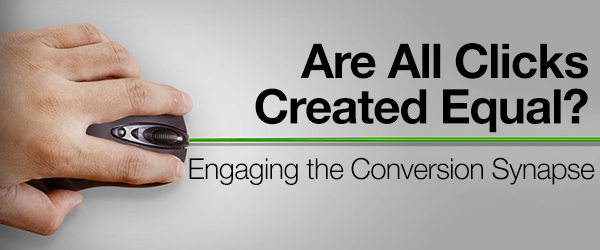Clicks; they are the driving force of online advertising. But is it as simple as that? The short answer is no – not anymore. These days, we aren’t just interested in clicks. Instead, we strive to understand the behaviour behind these clicks and even go as far as looking into the psychology of clicks – why did a user engage? If we understand the why, we inadvertently answer the more important question of how. The ‘how’ revolves around certain jargon terms such as UX (user experience), engagement and conversion (in that order!). While the main goal of any campaign or online endeavour is obviously conversions – we cannot forget the catalyst for conversions – the almighty engagement.
There are a few ways of measuring engagement, all of which are somewhat complex if you’re not paying attention to the finer details associated with these metrics. A couple of examples of different indicators of engagement are: time spent on page, pages viewed on a website and link clicks on a webpage. The trick here is to engage with the right people according to the campaign. We want to increase the quality of traffic to such a high level that most of these users are so vested in the content of the page that they basically convert themselves just by landing there.
This is known as high quality traffic. Finding the right traffic is one thing, but the important question is – what is the cost of engaging these visitors? Below are three of the many ways Benchmarketing tracks user engagement.
1. CPETV
Naturally, we can assume that someone who spends more time on a page is already a higher quality form of traffic than one who leaves immediately, and so it makes sense to focus on this user. Using tools such as Google Analytics and tracking/marketing tags help us to define how much we are paying for this user. We then synthesise it into a Cost Per Engaged/Timed Visitor (CPETV). For example, we could conclude that we are paying 90 cents per 60 seconds of someone staying on the site.
Benefit to our customers – investing more in the high quality traffic translates into a higher probability of that traffic converting as a lead or customer. This, in turn allows us to drive down the cost of engaged visitors.
2. CPEV
Google has a metric that they use which is known as bounce rate. A page bounce is when a user visits only one page and then leaves.A bounce rate is the rate at which users bounce. Essentially, if a user visits more than one page, they did not bounce and this can be very valuable data to know. Not only because it aligns directly with Google’s algorithm of calculating engagement, but also because it is a simple principle to analyse. One strategy is to count a user’s page views and when page views = 2 (meaning they viewed more than one page), we can confirm them as engaged users. We can then actively retarget this audience more aggressively as we already know they are high quality traffic.
Benefit to our customers – it is tracking per-unique-user so it gives a very accurate snapshot of one type of engaged user. The cost is going to be higher, but the quality of engagement will follow the trend and be higher too. Again, the outcome here is a reduced cost of acquiring high quality traffic that does not ‘bounce’.
3. WHAT’S THE POINT?
The resulting question should invariably be – how much should you be spending? The answer is dependent on what you’re trying to accomplish. If your conversion is associated with high price items, it is expected that you are willing to pay for a high cost of engagement, and vice-versa. Ultimately, different campaigns are going to require different approaches. Certain webpages will favour one approach, while another could prove pointless, given the architecture of the website and the mechanisms used for page-to-page engagement.
The expected target audience needs to be analysed extensively as well. Taking into account the tracking technologies being used is imperative, as they too will have a resounding effect on the success of an engagement campaign. The ability to track unique actions will always mitigate any data analytic discrepancies.
These strategies culminate into the ability to optimise campaign, heighten the quality of traffic and drive down costs. Once we have the indicator of traffic quality, the possibilities are endless and targeting becomes increasingly richer. The end game of all of this is the ability to deliver the best website and awareness traffic in today’s market.
Drop us a line at [email protected] – let’s engage the conversion synapse.




